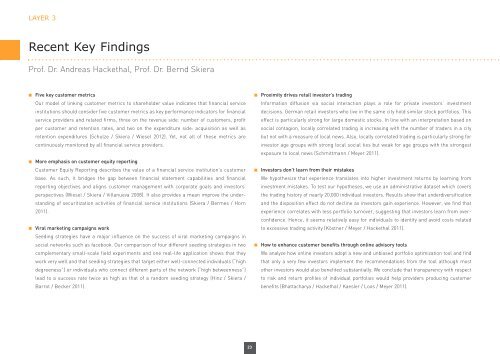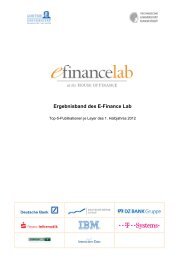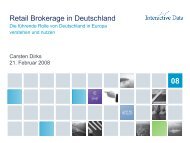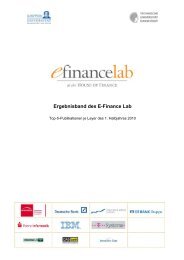The E-Finance Value Chain - E-Finance Lab Frankfurt am Main
The E-Finance Value Chain - E-Finance Lab Frankfurt am Main
The E-Finance Value Chain - E-Finance Lab Frankfurt am Main
You also want an ePaper? Increase the reach of your titles
YUMPU automatically turns print PDFs into web optimized ePapers that Google loves.
LAYER 3<br />
Recent Key Findings<br />
Prof. Dr. Andreas Hackethal, Prof. Dr. Bernd Skiera<br />
n Five key customer metrics<br />
Our model of linking customer metrics to shareholder value indicates that financial service<br />
institutions should consider five customer metrics as key performance indicators for financial<br />
service providers and related firms, three on the revenue side: number of customers, profit<br />
per customer and retention rates, and two on the expenditure side: acquisition as well as<br />
retention expenditures (Schulze / Skiera / Wiesel 2012). Yet, not all of these metrics are<br />
continuously monitored by all financial service providers.<br />
n More emphasis on customer equity reporting<br />
Customer Equity Reporting describes the value of a financial service institution's customer<br />
base. As such, it bridges the gap between financial statement capabilities and financial<br />
reporting objectives and aligns customer management with corporate goals and investors’<br />
perspectives (Wiesel / Skiera / Villanueva 2008). It also provides a mean improve the understanding<br />
of securitization activities of financial service institutions (Skiera / Bermes / Horn<br />
2011).<br />
n Viral marketing c<strong>am</strong>paigns work<br />
Seeding strategies have a major influence on the success of viral marketing c<strong>am</strong>paigns in<br />
social networks such as facebook. Our comparison of four different seeding strategies in two<br />
complementary small-scale field experiments and one real-life application shows that they<br />
work very well and that seeding strategies that target either well-connected individuals (“high<br />
degreeness”) or individuals who connect different parts of the network (“high betweenness”)<br />
lead to a success rate twice as high as that of a random seeding strategy (Hinz / Skiera /<br />
Barrot / Becker 2011).<br />
23<br />
n Proximity drives retail investor’s trading<br />
Information diffusion via social interaction plays a role for private investors’ investment<br />
decisions. German retail investors who live in the s<strong>am</strong>e city hold similar stock portfolios. This<br />
effect is particularly strong for large domestic stocks. In line with an interpretation based on<br />
social contagion, locally correlated trading is increasing with the number of traders in a city<br />
but not with a measure of local news. Also, locally correlated trading is particularly strong for<br />
investor age groups with strong local social ties but weak for age groups with the strongest<br />
exposure to local news (Schmittmann / Meyer 2011).<br />
n Investors don’t learn from their mistakes<br />
We hypothesize that experience translates into higher investment returns by learning from<br />
investment mistakes. To test our hypotheses, we use an administrative dataset which covers<br />
the trading history of nearly 20,000 individual investors. Results show that underdiversification<br />
and the disposition effect do not decline as investors gain experience. However, we find that<br />
experience correlates with less portfolio turnover, suggesting that investors learn from overconfidence.<br />
Hence, it seems relatively easy for individuals to identify and avoid costs related<br />
to excessive trading activity (Köstner / Meyer / Hackethal 2011).<br />
n How to enhance customer benefits through online advisory tools<br />
We analyze how online investors adopt a new and unbiased portfolio optimization tool and find<br />
that only a very few investors implement the recommendations from the tool although most<br />
other investors would also benefited substantially. We conclude that transparency with respect<br />
to risk and return profiles of individual portfolios would help providers producing customer<br />
benefits (Bhattacharya / Hackethal / Kaesler / Loos / Meyer 2011).








